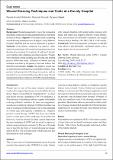| dc.contributor.author | Pamela Amatta Odhiambo, Kennedy Omondi | |
| dc.date.accessioned | 2020-11-30T05:54:10Z | |
| dc.date.available | 2020-11-30T05:54:10Z | |
| dc.date.issued | 2019 | |
| dc.identifier.uri | https://repository.maseno.ac.ke/handle/123456789/3028 | |
| dc.description.abstract | Background: Wound management is one of the commonest procedures conducted in surgical departments across health facilities in Kenya.
Objective: This study aimed at exploring wound dressing techniques used at Migori County Referral Hospital (MCRH) and the cost of treatment to patients.
Methods: Convenience sampling was used to select inpatients presenting with wounds undergoing treatment at the time of recruitment. Five patients (2 male and 3 female) were enrolled after obtaining informed consents. Wounds were examined during cleaning and dressing and healing process follow-ups made. Selection of wound dressing technique was done by the primary clinicians with no bias from the research team.
Results: One patient’s wound was an open fracture resulting from a road traffic accident; three patients had pyomyositis following thorn pricks; and the last patient’s was sustained following a blast injury. Wound management methods employed at MCRH included cleaning with vinegar, irrigation with normal saline, dressing with honey, and improvised negative pressure wound therapy. Total cost incurred was affordable to patients, and ranged between Kenya shillings 100–360 (USD 1–3.60) weekly.
Conclusion: Wound management techniques at MCRH were effective and affordable. Additional studies with a larger sample size are recommended | en_US |
| dc.publisher | The Surgical Society of Kenya | en_US |
| dc.subject | Wound dressing, costs, NPWT, vinegar cleaning, honey dressing | en_US |
| dc.title | Wound dressing techniques and costs at a county hospital | en_US |
| dc.type | Article | en_US |

